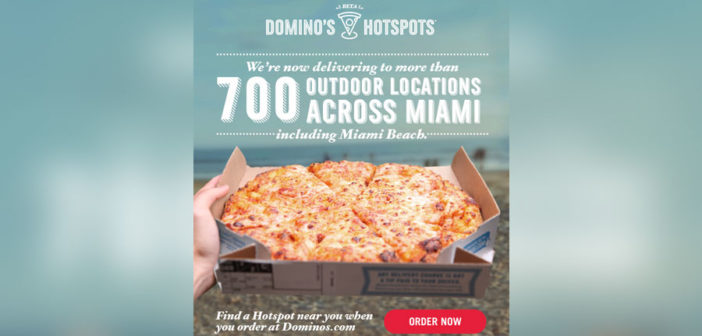Now that it has passed Pizza Hut for the title of No. 1-selling pizza chain in the world, Domino’s wants to keep the pedal to the metal and make its new position of supremacy unassailable. And not surprisingly, it’s leaning on its success in digital technology to bring it even more success.
In his last quarterly earnings call with analysts before he retires at the end of June, outgoing CEO Patrick Doyle highlighted growth expectations from digital initiatives such as the creation of delivery “hotspots” in outdoor locations such as parks, beaches, sports fields and parking lots, and an artificial intelligence pilot that’s expanding its award-winning Dom voice ordering system beyond a Facebook Messenger chatbot to Slack, Google Home and Alexa as part of its Domino’s Anyware digital ecosystem of ordering by tweet, smart TV and even a “zero click app” that’s just that—open it and the app will place your preferred order for you.

Betting on tech and digital innovation to transform its business and boost revenues, Domino’s plans to become a 100% digital business. In the last quarter, online orders account for about 65% of its activity. “Don’t underestimate what a big deal that could be for store-level profitability and for convenience,” Doyle said on the call.
The soon-to-depart CEO is streaking toward the finish line. Domino’s just posted a first-quarter same-store sales increase of 8.3% in the US, giving it 28 consecutive periods of positive growth, while international comps rose by 5% making the 97th consecutive quarter of same-store sales gains.
 We spoke with Dennis Maloney, Domino’s VP and chief digital officer, about the why (and the ROI) of his high-tech investments:
We spoke with Dennis Maloney, Domino’s VP and chief digital officer, about the why (and the ROI) of his high-tech investments:
Let’s start with the new hotspots; how do they work, and what’s the strategy there?
It’s been difficult to get a pizza delivery to a non-address: You’ve had to get on the phone and guide the delivery in; it’s a very manual process. We’ve found a way to make that happen within the digital space. We string together a bunch of technologies we’ve been using, but in a new and unique way. Customers know where they are, and we’re basically constructing virtual addresses for those hotspots.
Want to know what those coordinates were about? They're part of yet another delivery revolution! Over 150,000 Domino’s Hotspots are active nationwide. Get pizza delivered to places like parks, beaches & thousands of other unexpected outdoor locations. https://t.co/TUYd33sU1I pic.twitter.com/LRr91LKto5
— Domino's Pizza (@dominos) April 16, 2018
We have a big announcement tomorrow! Here’s a hint:
(38.624685583929526, -90.18432287583927)
(39.70697904462316, -76.06439933024726)
(36.08205030169928, -115.17278183732614)
(33.757890278528485, -117.77118267791727)
(38.88979908761198, -77.01252259103171)
Do you have any guesses?— Domino's Pizza (@dominos) April 15, 2018
The franchisees are the ones that are setting those up, and so they can be very comfortable about knowing locally where a driver is delivering—so it’s not in the middle of a four-lane highway or a beach where the driver will be wandering around for four hours. They are specific locations where people will congregate or where there is a valid need for a non-addressed pizza delivery.

So are customers already ordering Domino’s at the beach, or even in a parking lot?
Yes, we’ve already had pizza deliveries in a zoo parking lot. Also in a hotel parking lot, where the guest may not have been comfortable with a driver meeting him at the door to his room or even in the lobby. We’ve had golf courses, trailheads, piers and a bunch of locations in parks in New York. It’s crazy. And we’re literally just starting to learn about where customers think these hot spots might be valuable.

And what more can you tell us about how AI is enhancing Dom, your voice ordering system?
It’s really an extension of the learning functionality that we’ve been working on as a brand for five years through Dom, our natural-language voice-recognition platform. We’ve been using Dom within our web and mobile-web experiences as well as on Alexa and Google Home, and we’ve been working on a completely screenless voice process through a number of platforms. We’ve used those learnings to enable customers to interact with Dom on the phone.

So AI is helping expand the availability of what was originally a chatbot?
(Dom’s voice) recognition capabilities around natural language already exceed what you’d be able to recognize as a human being. Dom is as good at recognizing what you’re saying as a normal person is. The hard part is interpreting what a person is intending to do and make that work in the construct of a voice transaction with a computer.
That’s where AI comes in: learning those processes and how to refine them over time based on a number of experiences. That’s basically what AI does really well. If we can do that and create very good, repeatable processes in our stores as far as answering our phones are concerned, that will be the best and most consistent way to create a great and consistent pizza experience for all our customers.
Besides the cool factor of rolling out cutting-edge digital technology, is the biggest pay-off the efficiencies these technologies create for customers and employees?
The best thing our team members can be doing in our stores is making great pizza. If we can get people off the phones—sometimes that phone experience isn’t going to be great because they’re so busy. There’s so much stuff going on that they want to go back to making pizzas. If we can let them go and do stuff they want to do—making pizza and interacting with customers in the store—that works out great.
–
This article first appeared in www.brandchannel.com
Seeking to build and grow your brand using the force of consumer insight, strategic foresight, creative disruption and technology prowess? Talk to us at +9714 3867728 or mail: info@groupisd.com or visit www.groupisd.com

